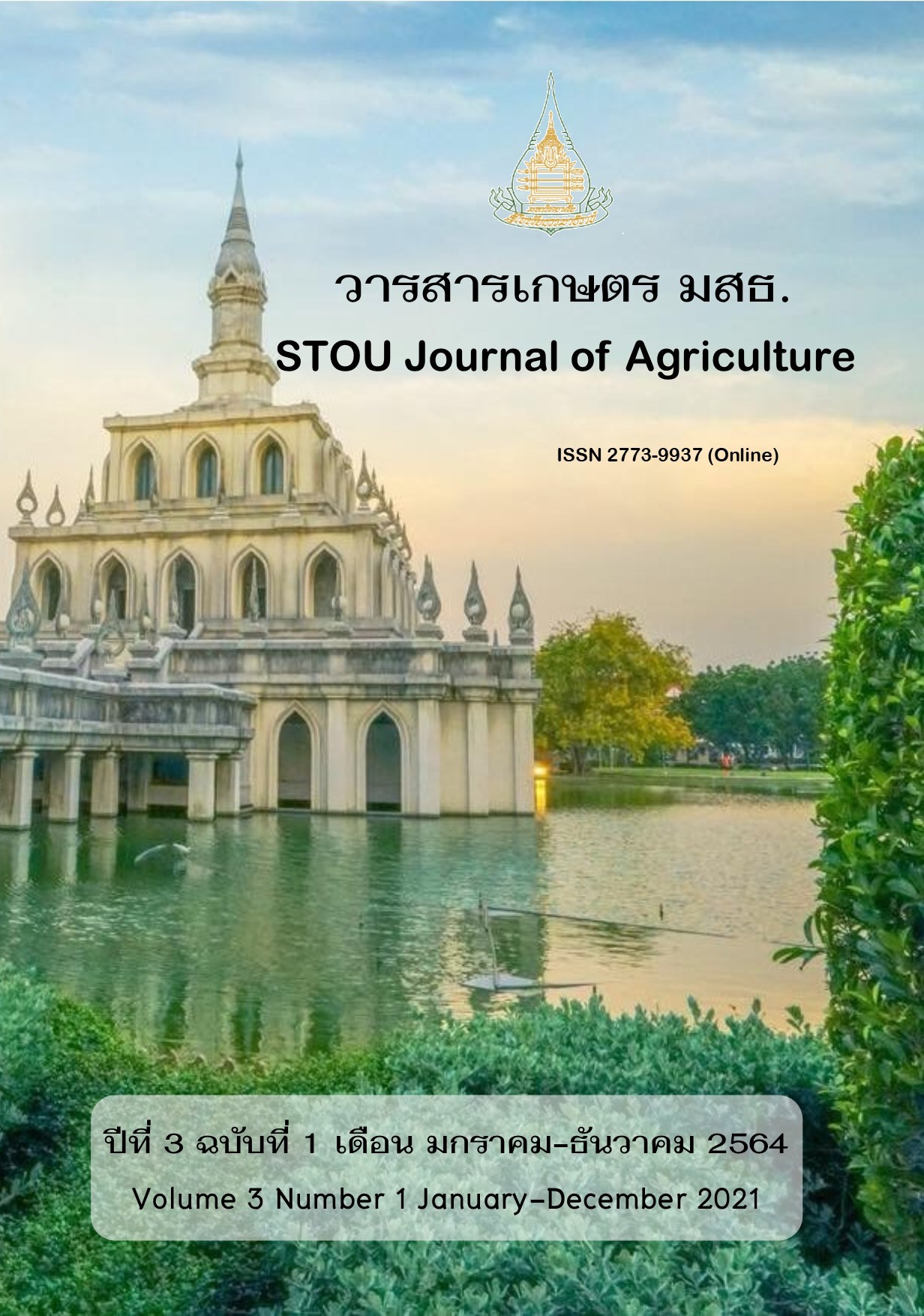การใช้เทคโนโลยีสารสนเทศเพื่อการผลิตพืชเศรษฐกิจของเกษตรกร
Main Article Content
บทคัดย่อ
การวิจัยนี้มีวัตถุประสงค์เพื่อศึกษาข้อมูลของเกษตรกรในด้าน 1) สภาพทางสังคมและเศรษฐกิจ 2) การรับรู้ข้อมูลข่าวสาร 3) การใช้เทคโนโลยีสารสนเทศ 4) คุณลักษณะของเทคโนโลยีสารสนเทศที่เกษตรกรสามารถนำไปปรับใช้ในการผลิตพืชเศรษฐกิจ และ 5) ปัญหาและข้อเสนอแนะเกี่ยวกับการใช้เทคโนโลยีสารสนเทศเพื่อการผลิตพืชเศรษฐกิจ การวิจัยนี้เป็นการวิจัยเชิงสำรวจ ประชากรที่ศึกษา คือ เกษตรกรผู้ปลูกพืชเศรษฐกิจที่เข้าร่วมโครงการต่าง ๆ ได้แก่ ข้าว 220 คน อ้อย 220 คน มันสำปะหลัง 200 คน และปาล์มน้ำมัน 370 คน โดยกำหนดขนาดตัวอย่างโดยใช้สูตรทาโร่ ยามาเน่ ที่ค่าความคลาดเคลื่อน 0.07 ได้กลุ่มตัวอย่าง 122 คน 106 คน 102 คน และ 132 คน ตามลำดับ เก็บรวมรวมข้อมูลโดยใช้แบบสอบถาม วิเคราะห์ข้อมูลโดยใช้สถิติพรรณนา ผลการวิจัยพบว่า 1) เกษตรกรส่วนใหญ่เป็นเพศชาย อายุเฉลี่ย 49.84 ปี จบประถมศึกษา มีการใช้วิทยุโทรทัศน์ และโทรศัพท์มือถือ 2) รับรู้ข่าวสารจากเจ้าหน้าที่ส่งเสริมการเกษตร เพื่อนบ้าน สื่อกิจกรรม และสื่อสิ่งพิมพ์ 3) มีวัตถุประสงค์ในการใช้เทคโนโลยีสารสนเทศเพื่อเพิ่มพูนความรู้และเพื่อทราบข้อมูลข่าวสาร โดยเห็นว่าเทคโนโลยีสารสนเทศมีประโยชน์ คือ ได้รับข่าวสารที่ทันสมัย ทำให้การเรียนรู้ง่ายขึ้น ช่วยในการตัดสินใจเกี่ยวกับการผลิต ความสะดวกในการติดต่อสื่อสาร และการเชื่อมโยงเครือข่าย 4) เห็นด้วยในระดับมากในประเด็นคุณลักษณะของเทคโนโลยีสารสนเทศที่เหมาะสม ได้แก่ การเข้าถึงข้อมูลข่าวสารได้รวดเร็ว การเรียนรู้แล้วนำมาฝึกทำเองได้ การเข้าถึงข้อมูลข่าวสารได้ง่าย เนื้อหาสอดคล้องกับความต้องการ การนำเสนอข้อมูลที่เป็นประโยชน์ในการผลิตและการตลาดทางการเกษตร การนำเสนอได้ถูกต้องแม่นยำและสอดคล้องกับความเป็นจริง 5) มีปัญหา คือ ไม่สามารถประยุกต์ใช้เทคโนโลยีสารสนเทศในการเรียนรู้เพื่อการผลิตได้ และเครื่องมืออุปกรณ์ที่มีอยู่ไม่ทันสมัยต่อการใช้งาน
Article Details
บทความที่ได้รับการตีพิมพ์เป็นลิขสิทธฺ์ของวารสารเกษตร มสธ.
ข้อความที่ปรากฎใน
เอกสารอ้างอิง
กระทรวงเทคโนโลยีสารสนเทศและการสื่อสาร. (2554). กรอบนโยบายเทคโนโลยีสารสนเทศและการสื่อสาร ระยะ พ.ศ. 2554-2563 ของประเทศไทย. กรุงเทพมหานคร: กระทรวงเทคโนโลยีสารสนเทศและการสื่อสาร.
สินีนุช ครุฑเมือง แสนเสริม, เบญจมาศ อยู่ประเสริฐ, บำเพ็ญ เขียวหวาน, พลสราญ สราญรมย์, ณรัฐ รัตนเจริญ, เจนณรงค์ เทียนสว่าง, เพชร ทวีวงษ์, ศิริวรรณ หวังดี, กัลยาณี เด็ดดวง, ศิริเพ็ญ ลาภวงศ์เมธี, พิชญาภัค จันทร์นิยมาธรณ์ และมารตี ชัยชนะเดช. (2558). การศึกษาพฤติกรรมการเรียนรู้ การใช้เทคโนโลยีสารสนเทศที่เหมาะสมกับเกษตรกรไทย. นำเสนอต่อ ศูนย์เทคโนโลยีอิเล็กทรอนิกส์และคอมพิวเตอร์แห่งชาติ สำนักงานพัฒนาวิทยาศาสตร์และเทคโนโลยีแห่งชาติ. นนทบุรี: สาขาวิชาเกษตรศาสตร์และสหกรณ์ มหาวิทยาลัยสุโขทัยธรรมาธิราช.
สำนักงานพัฒนาการวิจัยการเกษตร (องค์การมหาชน). (2564). พืชเศรษฐกิจ สินค้าสร้างรายได้ในครัวเรือนและประเทศ. สืบค้นจาก https://www.arda.or.th/knowledge_detail.php?id=40
สำนักวิจัยเศรษฐกิจการเกษตร. (2563). สถานการณ์สินค้าเกษตรที่สำคัญและแนวโน้ม ปี 2564. กรุงเทพมหานคร: สำนักงานเศรษฐกิจการเกษตร.
สำนักงานเศรษฐกิจการเกษตร. (2560). ยุทธศาสตร์การเกษตรต่างประเทศของกระทรวงเกษตรและสหกรณ์ พ.ศ. 2560-2564. กรุงเทพมหานคร: สำนักงานเศรษฐกิจการเกษตร.
สำนักงานสถิติแห่งชาติ. (2559). สรุปผลที่สำคัญสำรวจการมีการใช้เทคโนโลยีสารสนเทศและการสื่อสารในครัวเรือน พ.ศ. 2559. นนทบุรี: สำนักสถิติพยากรณ์.
DTAC. (2016). ประกาศผลเกษตรกรสำนึกรักบ้านเกิด ประจำปี 2559. สืบค้นจาก https://www.dtac.co.th/ pressroom/news/smart-farmer-016.html


